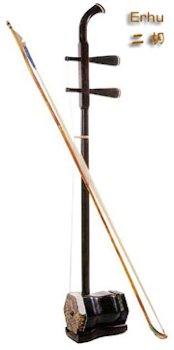
|
Chinese Musical Instruments - Instrument 1
Erhu - Bowed String Instrument - Page 2 During the Dynasties of Ming (1368-1644) and Qing (1644-1911), the erhu underwent a great development at the time of the golden age of the local operas. The erhu then developed in a different "schools". Two famous artists Hua Yanjun (1893-1950) and Liu Tianhua (1895-1932) made an exceptional contribution to the improvement of the erhu, and it was indeed due to the latter that the erhu, an instrument mainly for accompaniment in an opera, becomes a solo instrument. After the foundation of People's Republic of China (1949), the manufacture of the erhu, the playing techniques, the repertoire as well as the musical education of this instrument have undergone a rapid development. The repertoire has grown rapidly in the genres of solo, with ensemble as well as concerti with symphony orchestra. The sound body of the erhu is a drum-like little case usually made of ebony or sandalwood and snakeskins. It usually has a hexagonal shape with the length of approximately 13 cm. The front opening is covered with skin of python (snake) and that of the back is left open. The functions of this case of resonance are to amplify the vibrations of the strings. The neck of the erhu is about 81 cm long and is manufactured with the same materials as the drum. The top of the stem is bent for decoration. The two tuning handles (pegs) are found close to the end of the stem. There is no frets (as contrast to the lute) or touching board (as contrast to violin). The player creates different pitches by touching the strings at various positions along the neck of the instrument. The bow is 76 cm long and is manufactured of reed which one curves during cooking, and arched with horsehair in the same way as the bow of violin. However, in the case of erhu, the horsehair runs between the two strings. In another word, one cannot take off the bow from the instrument unless one of the two strings is taken off or broken. ⇦ Return |